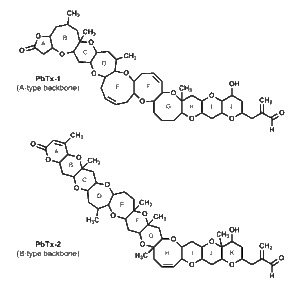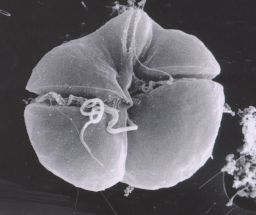Brevetoxin: Difference between revisions
(Content addition) |
No edit summary |
||
| Line 2: | Line 2: | ||
==Introduction== | ==Introduction== | ||
Brevetoxin is a kind of neurotoxin produced by <i>Karenia brevis</i>. [http://www.nmfs.noaa.gov/pr/pdfs/health/brevetoxin.pdf] | Brevetoxin is a kind of neurotoxin produced by <i>Karenia brevis</i>. [http://www.nmfs.noaa.gov/pr/pdfs/health/brevetoxin.pdf] <i> K. brevis </i> is a species of dinoflagellate, a group of the Kingdom Protista. They are a kind of algae, which means they are subject to the occurence of algal blooms, in which the ordinarily less noticeable populations of algae explode to much more noticeable levels. It is at these levels that <i> K. brevis </i> begins to pose a problem, as the brevetoxin it produces reaches concentrations high enough to harm humans. <br> <br>Although a number of <i>Karenia</i> species have been described as of yet, <i>K. brevis</i>, the main producer of brevetoxin, occurs primarily in the Gulf of Mexico, particularly on the Western Gulf coast of Florida. It occurs in other parts of the Gulf as well, as far west as the Texas coast. <i>K. brevis</i> occurence outside the Gulf of Mexico is uncommon, but it infrequently occurs in the waters of the Indian River Lagoon on the Atlantic coast of Florida. A bloom in 2007-2008 was enough to bring <i> K. brevis </i> levels in the lagoon high enough to make the shellfish in the area dangerous for consumption. Algal blooms can occur at virtually any time of year, but their occurrence seems to be increased between the months of September and February.[http://www.sms.si.edu/irlspec/Kareni_brevis.htm] <br> | ||
< | |||
==Affliction and Symptoms== | ==Affliction and Symptoms== | ||
The amount of toxin produced in small numbers of these <i> K. brevis</i> is typically not dangerous. However, when they reproduce en masse, as in the case of the red tide algal blooms, enough brevetoxin is generated to be considered dangerous to humans, as well as other kinds of life. Wildlife is most directly affected, specifically those species which depend on or live in the ocean, such as fish, water fowl, sea turtles and dolphins. Humans tend to be intelligent enough not to swim directly in the red tides, although exposure of brevetoxin to skin can lead to toxic effects. Instead, humans are most often exposed to brevetoxin through consumption of shellfish contaminated with the chemical. In rare cases, inhalation is possible if brevetoxins are swept into the air by ocean surf or onshore winds.[http://www.nmfs.noaa.gov/pr/pdfs/health/brevetoxin.pdf][[Image:K brevis1.jpg|thumb|300px|right|<i>K. brevis</i>, responsible for brevetoxin production. Location on page subject to change.[http://www.dep.state.fl.us/northwest/Ecosys/waterquality/envirofact2.htm]]] | The amount of toxin produced in small numbers of these <i> K. brevis</i> is typically not dangerous. However, when they reproduce en masse, as in the case of the red tide algal blooms, enough brevetoxin is generated to be considered dangerous to humans, as well as other kinds of life. Wildlife is most directly affected, specifically those species which depend on or live in the ocean, such as fish, water fowl, sea turtles and dolphins. Humans tend to be intelligent enough not to swim directly in the red tides, although exposure of brevetoxin to skin can lead to toxic effects. Instead, humans are most often exposed to brevetoxin through consumption of shellfish contaminated with the chemical. In rare cases, inhalation is possible if brevetoxins are swept into the air by ocean surf or onshore winds.[http://www.nmfs.noaa.gov/pr/pdfs/health/brevetoxin.pdf][[Image:K brevis1.jpg|thumb|300px|right|<i>K. brevis</i>, responsible for brevetoxin production. Location on page subject to change.[http://www.dep.state.fl.us/northwest/Ecosys/waterquality/envirofact2.htm]]]<br><br>Illness onset following consumption of contaminated shellfish is known as Neurotoxic Shellfish Poisoning, or NSP, wherein brevetoxins will proceed to affect the gastro-intestinal (GI) tract as well as the neurological system. GI tract related symptoms include vomiting, diarrhea and pain in the abdomen. Neurological symptoms consist of paresthesia (a pricking, tingling sensation), reversal of perception of hot and cold temperature sensation, vertigo (false sense of motion), and ataxia (involuntary muscular movement, or spasms). Inhalation of brevetoxin may result in coughing, dyspnea (shortness of breath), and bronchial spasms. [http://www.bt.cdc.gov/agent/brevetoxin/casedef.asp] No human fatalities have yet been attributed to NSP, but the concentrations of brevetoxins produced in annual algal blooms are responsible for significant annual animal fatalities along the Gulf of Mexico and the south/mid-Atlantic coast. [http://www.nmfs.noaa.gov/pr/pdfs/health/brevetoxin.pdf] | ||
<br><br> | |||
Illness onset following consumption of contaminated shellfish is known as Neurotoxic Shellfish Poisoning, or NSP, wherein brevetoxins will proceed to affect the gastro-intestinal (GI) tract as well as the neurological system. GI tract related symptoms include vomiting, diarrhea and pain in the abdomen. Neurological symptoms consist of paresthesia (a pricking, tingling sensation), reversal of perception of hot and cold temperature sensation, vertigo (false sense of motion), and ataxia (involuntary muscular movement, or spasms). Inhalation of brevetoxin may result in coughing, dyspnea (shortness of breath), and bronchial spasms. [http://www.bt.cdc.gov/agent/brevetoxin/casedef.asp] No human fatalities have yet been attributed to NSP, but the concentrations of brevetoxins produced in annual algal blooms are responsible for significant annual animal fatalities along the Gulf of Mexico and the south/mid-Atlantic coast. [http://www.nmfs.noaa.gov/pr/pdfs/health/brevetoxin.pdf] | |||
<br>At right is a sample image insertion. It works for any image uploaded anywhere to MicrobeWiki. The insertion code consists of: | <br>At right is a sample image insertion. It works for any image uploaded anywhere to MicrobeWiki. The insertion code consists of: | ||
Revision as of 01:02, 6 December 2013

Introduction
Brevetoxin is a kind of neurotoxin produced by Karenia brevis. [3] K. brevis is a species of dinoflagellate, a group of the Kingdom Protista. They are a kind of algae, which means they are subject to the occurence of algal blooms, in which the ordinarily less noticeable populations of algae explode to much more noticeable levels. It is at these levels that K. brevis begins to pose a problem, as the brevetoxin it produces reaches concentrations high enough to harm humans.
Although a number of Karenia species have been described as of yet, K. brevis, the main producer of brevetoxin, occurs primarily in the Gulf of Mexico, particularly on the Western Gulf coast of Florida. It occurs in other parts of the Gulf as well, as far west as the Texas coast. K. brevis occurence outside the Gulf of Mexico is uncommon, but it infrequently occurs in the waters of the Indian River Lagoon on the Atlantic coast of Florida. A bloom in 2007-2008 was enough to bring K. brevis levels in the lagoon high enough to make the shellfish in the area dangerous for consumption. Algal blooms can occur at virtually any time of year, but their occurrence seems to be increased between the months of September and February.[4]
Affliction and Symptoms
The amount of toxin produced in small numbers of these K. brevis is typically not dangerous. However, when they reproduce en masse, as in the case of the red tide algal blooms, enough brevetoxin is generated to be considered dangerous to humans, as well as other kinds of life. Wildlife is most directly affected, specifically those species which depend on or live in the ocean, such as fish, water fowl, sea turtles and dolphins. Humans tend to be intelligent enough not to swim directly in the red tides, although exposure of brevetoxin to skin can lead to toxic effects. Instead, humans are most often exposed to brevetoxin through consumption of shellfish contaminated with the chemical. In rare cases, inhalation is possible if brevetoxins are swept into the air by ocean surf or onshore winds.[5]

Illness onset following consumption of contaminated shellfish is known as Neurotoxic Shellfish Poisoning, or NSP, wherein brevetoxins will proceed to affect the gastro-intestinal (GI) tract as well as the neurological system. GI tract related symptoms include vomiting, diarrhea and pain in the abdomen. Neurological symptoms consist of paresthesia (a pricking, tingling sensation), reversal of perception of hot and cold temperature sensation, vertigo (false sense of motion), and ataxia (involuntary muscular movement, or spasms). Inhalation of brevetoxin may result in coughing, dyspnea (shortness of breath), and bronchial spasms. [6] No human fatalities have yet been attributed to NSP, but the concentrations of brevetoxins produced in annual algal blooms are responsible for significant annual animal fatalities along the Gulf of Mexico and the south/mid-Atlantic coast. [7]
At right is a sample image insertion. It works for any image uploaded anywhere to MicrobeWiki. The insertion code consists of:
Double brackets: [[
Filename: PHIL_1181_lores.jpg
Thumbnail status: |thumb|
Pixel size: |300px|
Placement on page: |right|
Legend/credit: Electron micrograph of the Ebola Zaire virus. This was the first photo ever taken of the virus, on 10/13/1976. By Dr. F.A. Murphy, now at U.C. Davis, then at the CDC.
Closed double brackets: ]]
Other examples:
Bold
Italic
Subscript: H2O
Superscript: Fe3+
Section 1
Include some current research, with at least one image.
Section 2
Include some current research, with a second image.
Conclusion
Overall text length should be at least 1,000 words (before counting references), with at least 2 images. Include at least 5 references under Reference section.
References
ASK PROF.S ABOUT SAME SOURCE IN MULTIPLE PLACES AND LINKABLE REFERENCES
Edited by [Author Name], student of Joan Slonczewski for BIOL 116 Information in Living Systems, 2013, Kenyon College.
